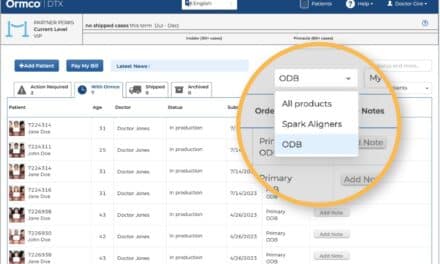by Tina Byrne
“Are we there yet?”

Tina Byrne
Over the past few years, orthodontic practices have increasingly and enthusiastically transitioned to electronic business functions. We clearly recognize the efficiency of managing and marketing our practices using technology and the Internet. Computerized processes can integrate automated messages and reminders, online and scheduled payment options, financial risk assessment, treatment planning, appliance fabrication, case presentation, and even patient reward programs for treatment compliance.
That being said, why isn’t electronic insurance claim submission receiving the same level of use? According to several leading orthodontic practice management software (PMS) companies, only 20% to 25% of customers are using electronic claims submissions with their PMS program. An even more advantageous service, electronic eligibility verification, has little, if any, streamlined integration for the orthodontic industry.
E-Claims
If your practice is using one of the major orthodontic PMS systems, I recommend the move to electronic claims submission. The recurring responses I receive from staff members for not using e-claims are that: 1) Claims are rejected; 2) Not all insurance carriers accept e-claims; 3) e-claims offer no time savings for the office; and 4) e-claims give no significant cost savings versus mailing claims.
Overcoming e-claim rejection is a matter of paying attention to detail. The majority of rejected claims are due to invalid field information, coding, or patient information. Electronic data interchange (EDI), the computer-to-computer exchange of business information, is a standard format. It is very simple to modify your process to meet the information requirements. When a claim is rejected, you are made aware within minutes and are able to correct errors. With manual submission, you often don’t know about a rejection for 4 to 5 weeks.
It is true that not all insurance carriers accept electronic submission. However, the clearinghouse (the vendor partnered with your PMS) will send that claim to the insurance company in a paper format. I also suggest to my practices that when there is an insurance carrier who refuses standard ADA forms and mandates the paperwork they provide, you can attempt to process their form as an attachment to an electronic claim.
An electronic claim clearinghouse provides a single location to manage all your claims. Clearinghouses offer efficient adjudication, send payments in as few as 10 days, and allow your staff to follow the status of a claim at any given time. A reduction in staff time and an overall cost savings may not be evident immediately, but it can be realized within a short period of time.

Eligibility and Benefit Verification
It has been more than 15 years since I worked as an orthodontic practice administrator. One of the tasks I was accountable for was managing the insurance. I am astounded at the number of practices I encounter today that are using the same arduous methods to confirm eligibility, submit ongoing claims, and retain explanation of benefit (EOB) information that were in place more than a decade ago.
While many offices have yet to progress to an efficient means of verifying eligibility and benefit information, I do understand why they feel the need to “pick up the phone.” Today, an accurate determination of a patient’s insurance coverage is complicated by benefit plans riddled with limitations, exclusions, waiting periods, new coordination of benefit policies, and code restrictions for orthodontic services. Additionally, third-party administrators (TPAs) have become prominent players and added an additional “layer” to the insurance industry and its processes.
In the course of my collaboration with hundreds of offices each year, either through in-office consulting sessions or insurance seminars, staff members have concurred that we have yet to come across a single service capable of providing comprehensive benefit plan information for all patients. Insurance company Web sites still emerge as the most reliable online source of patients’ eligibility data, and staff are left “holding the phone” in an effort to obtain precise benefit details.
Although electronic claims submission appears worthy of consideration, we can only hope that a real-time eligibility solution that meets our needs will soon be available.
Master Your Plan
You can make you insurance workflow more efficient by making the most of your PMS and existing Web-based information. Many offices require a bit of planning, training, and only a few changes for it to all come together.
Regardless of whether your practice does or does not accept assignment of benefit, has only a few PPO cases, or is 100% managed care, it helps to establish an insurance philosophy with some simple Do’s and Don’ts. You hire and teach your staff to be as customer service-oriented as possible, yet that way of thinking and their desire to please patients can get them more involved than they should be in working with insurance.
DO: Maintain ongoing education and communicate with your patients (or responsible parties) about their insurance. Orthodontic coverage is more than likely a benefit they have not previously used and works differently from other benefits. They are trained to know co-payments.
DO: Think differently about “pre-credit.” Offices that pre-credit an anticipated amount of insurance coverage at the onset of treatment must have a verification of benefits. You may have the mind-set that you have to get the amount spot-on because you “take it off” of the patient’s fee. This thinking needs to be realigned. You are pre-crediting, so any time a discrepancy is found, communicate with the patient, take action, and make adjustments.
DO: Provide timely and accurate claim submission.
DO: Get off the phone. Obtain printed benefit information whenever possible, preferably from the Internet. The insurance carrier’s information is your backup, and there is room for dispute if there is no disclosure of exclusions or a waiting period. Inform the patient of these possibilities and, if they are a concern, guide the patient to check on them. Make it a point to confirm your pre-credited amount on the EOB accompanying the initial payment.
DO: Stick to the contract. If you get insurance claims after the start of treatment, do not verify benefits. Simply submit the claim. If possible, have payment go directly to the subscriber. If you are going to pre-credit, consider doing it only if treatment has not progressed past a certain period of time.
DO: Keep the responsible party involved until you receive the entire benefit, particularly when payment is not received as expected. Patients sometimes don’t realize that their benefit is not entirely paid at the onset of treatment.
DON’T: Own responsibility of benefits by chasing down overdue insurance payments or unpaid benefits. Your contract should contain a clause stating that the patient is responsible for the entire amount. If there is a change in plans during the course of treatment, do not automatically verify benefits. Maintain the pre-credited amount of your contract until the new insurance activates the claim and you can determine if there is any change to the original amount.
Carefully review all EOBs that accompany insurance payments for codes and notations. Otherwise, you are missing information right under your nose. If a benefit has been terminated, transfer the entire amount of the pre-credited balance back to the patient as a single payment, generate a statement/letter with a copy of the EOB, and expect payment—or at least a call to arrange payment.
Make your first communication to patients when insurance is 45 days overdue. Inform the patient of your policy to transfer and request payment of any remaining pre-credited insurance at the 60-day past-due point. Request their assistance in contacting their insurance company as they are “entitled” to a prompt response. Now you have their attention!
DON’T: Question benefit amounts if they are different from expected. Your job is to keep the patient informed. Patients will take a role in insurance inquiries if you inform them that you cannot question their benefits and that they are “entitled” to a prompt response.
DON’T: Place your doctor or practice at risk by trying to be “creative” in submitting insurance for a patient. Every office has had at least one patient (often many) who has had a special request for specific dates or amounts to be submitted on their claim. Insurance companies use a formulary to determine how fees are earned, and you should adopt that same approach when allocating amounts for treatment fees.
For a complete list of companies offering practice-management software, visit our online Buyer’s Guide.
There are two things you can count on with insurance: change and variables, neither of which you can control. However, you can create an efficient internal structure with the standardization of tasks, the centralization of information, and office policies and guidelines.
Insurance has always been, and will continue to be, about staying on top of the game. As for EDI, we have yet to arrive. So as the journey continues down the electronic data interchange, sorry to say, we are not there yet!
Tina Byrne has been working and consulting in the field of orthodontics for more than 30 years. Formerly a senior consultant with a dental consulting firm, she has helped guide the success of specialty and dental practices throughout the world. She can be reached through her Web site, byrne-consulting.com.









